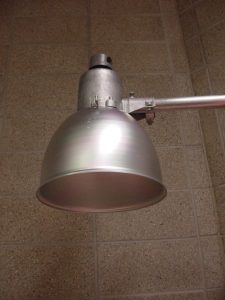Yard Lights
Many farms have a yard light at a central location on the farmstead. These lights are turned on by a photo-control and operate on a year round basis for an average of 12 hours per day. A large proportion (about 30% or more) of the light from a typical yard light never makes it to the intended target (the ground); the light goes up or sideways. If a fixture is used with a full cut-off parabolic reflector such as the Hubbell Skycap (see photo) or a GE Sky Guard, 47% more light will make it to the ground, which means the fixture could be replaced with a lower wattage lamp and still maintain the same amount of illumination of the target area. If the lamp type was changed from a mercury vapor (MV) to a high pressure sodium (HPS) or metal halide (MH) lamp, the wattage could be reduced further because these lamps emit more lumens (light) per watt. The typical 175-watt MV yard light uses about 200 watts when the ballast losses are included which amounts to 876 kWh of electricity per year or $105 per year cost at $0.12/kWh. If the MV lamp fixture is replaced with a 70-watt HPS fixture with a full cutoff reflector, the operating cost would be reduced to $55 per year. The cost of the fixture is estimated at $100 for a 4.0 year payback with a $100 installation cost included.
(see photo) or a GE Sky Guard, 47% more light will make it to the ground, which means the fixture could be replaced with a lower wattage lamp and still maintain the same amount of illumination of the target area. If the lamp type was changed from a mercury vapor (MV) to a high pressure sodium (HPS) or metal halide (MH) lamp, the wattage could be reduced further because these lamps emit more lumens (light) per watt. The typical 175-watt MV yard light uses about 200 watts when the ballast losses are included which amounts to 876 kWh of electricity per year or $105 per year cost at $0.12/kWh. If the MV lamp fixture is replaced with a 70-watt HPS fixture with a full cutoff reflector, the operating cost would be reduced to $55 per year. The cost of the fixture is estimated at $100 for a 4.0 year payback with a $100 installation cost included.
If you have questions about the information on this site, please contact
Scott Sanford, Distinguished Outreach Specialist, University of Wisconsin, sasanford@wisc.edu.



